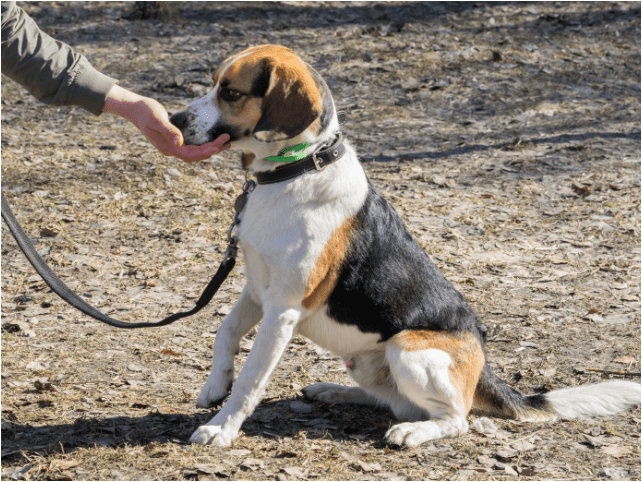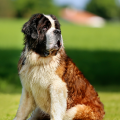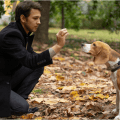Table of Contents
Teaching your Beagle to obey commands isn’t just done to impress other people, although it is definitely a plus. No, basic commands like Sit, Stay, and Come are actually crucial because they can help save your dog’s life. For example, your Beagle is on the other side of the road and wants to run to your side – commanding him to sit and stay would ensure that he doesn’t run recklessly.
Basic Commands
Before heading straight into crazy tricks and what-not, you need to train your Beagle with some basic commands; They’re not only fun (and useful), but also essential for both the well-being, good behavior, and further training of your companion.
The following 5 commands are absolutely essential for the advanced commands. In fact, most advanced commands are actually a chain of basic commands ordered in a particular fashion!
The commands in question are the following:
- Sit
- Lay
- Come
- Stay
- Leave
Sit Command
This is the classic command, no dog-owner can say his furry friend is trained without having him do a mere “sit” first.
This command is also essential for the more advanced orders, and at first, teaching this trick to your friend shouldn’t be hard at all! Although, if this is your first time training your dog, it will definitely take a bit of time.
The steps to train your Beagle are the following:
- Remember when I told you that you’d need a lot of treats for the training? Well, it is time to use them! Start by bringing a treat in your hand. Hold it close your dog to get his attention.
- Your dog will definitely turn its head to you expectantly, when you have his attention, slowly raise your hand; you will notice that your dog will track your hand with his eyes, and once your hand is up enough, he will sit in order to not strain his neck at a sharp 90-degree angle.
- Once the dog has sitting firmly on the ground, firmly say “sit” and then give it the treat, proceed to praise him for being the best dog around!
- Once he sits, congratulations! You’re well on your way to training him to sit. Firmly say “sit” when he is sitting, and proceed to give him the treat and some praise, this part is important because your dog will associate having a treat and praise with the act of “sitting”.
- Tip: If your Beagle is not sitting reflexively, you can press his haunches while pulling up on the leash to help him into the position. Don’t abuse this though!
These three steps are pretty basic and straightforward, be sure to repeat them several times per day, about 3 per day would be alright. Don’t overdo the training! It’s not really going to take you anywhere until the command is locked in.
After a week or two, you should notice that your dog will follow your order without a treat.
It is important to slowly take off the treats as well, during the training, after some effective days of sitting for treats, you should cut the treats, in order to have him follow you without them.
Besides being a supportive command for the advanced sequences, the “sit” command is super important, you can calm your canine when you’re eating dinner or having some guests over, or maybe you’re going to handle something dangerous like boiling water and you’d prefer if your dog stayed put in a corner.
Lay Command
Beagles are somewhat submissive, so training one to lay down shouldn’t be too tricky. Keeping your dog happy and relaxed will definitely make things easier, otherwise, he might feel hesitant to lay at first.
The steps to train your Beagle are the following:
- Start by bringing a treat in your hand. Hold it close your dog to get his attention.
- Clench your fist, hiding the treat within, and slowly move it to the ground level. Your furry friend will most likely stretch in the floor to sniff the treat.
- If he didn’t stretch immediately, just move your hand forward, between his forelegs, and then back, away from him. This way he will track your hand with his head back, and then he will stretch to reach your fist when you move it away.
- Once he lays, congratulations! You’re well on your way to training him to lay. Firmly say “lay” when he is laying on the ground, and proceed to give him the treat and some praise, this part is important because your dog will associate having a treat and praise with the act of “laying”.
Do you see the trick already? Your dog will do things because he wants the reward, that being a tasty treat and some loving praise. This is how the training of dog goes, it is a matter of giving the right signals, rewarding, and praising your dog.
These steps are pretty easy and straightforward like the previous steps for training the “sit” command, but they shouldn’t be repeated as much per day.
If your dog doesn’t complete the requirements (if he doesn’t stretch completely or if he lunges to take the treat) you need to discourage that attitude by firmly saying “no” and removing your hand (and the treat) from the ground. It is of utmost importance that you don’t give him the treat, as this will make your dog think about what he did to not receive the treat.
You have to instill obedience in your companion, so train him to follow the pattern of “do X to receive treat”. It is the best thing you can do.
I recommend you thoroughly exercise both the “sit” and “lay” commands with your dog before going for the next commands, as these two will be absolutely necessary for the next sequences.
Excellent! Don’t feel frustrated if your Beagle is being a bit stubborn for this one, just keep trying.
Come Command
The most useful command you can teach to your Beagle, bar none. Whenever your dog breaks out of the leash for any reason (It is not always your/his fault, entropy gets us eventually) you won’t have to chase him (a dog running at 40 km/h) any longer!
But in the event your dog decides to start rushing directly into a roadway, you will have the ability to save him from doing that.
The steps to train your doggy are the following:
- Hopefully, you’ve got a long leash. You will need it! Put the leash on his collar and then order your Beagle to sit, do so until he stays without following you.
- Make some distance with the dog, but not too much or he might stand up on his own accord to follow you.
- Swiftly tug the leash in your direction. If your dog begins his walk toward you, congratulations! You’re well on your way to training your dog to come over. Proceed to give him a treat and his much-deserved praise.
This sequence isn’t complex or anything, so be sure to repeat it about 2 or 3 times per day. As you progress the training, start making more distance between you and your dog, and then start doing it without the leash.
When everything is done, he will likely follow you without treats in the way!
Like the fastest steed, this recall command will bring back your companion at full speed!
Stay Command
This command will require your Beagle to sit, just like the “come” command, and its purpose is suiting your dog to patience and obedience because if you tell your dog to sit he might decide to stand up and not obey further “sit” commands.
Training the “stay” command will help you maintain your dog at a distance for a longer time than a mere “sit”.
The steps to train your doggy are the following:
- Get your dog in a particular spot every time you get to train the command to be sure to bring him over to the same spot.
- Put your dog in “sit” in the designated spot, then open your palm in front of his face and firmly say “stay”.
- Make some distance between you and the dog, not too far initially as he might stand up. Set a time goal; keep it short at first.
- If your dog stays put for at least the time goal you set, congratulations! Your dog is becoming more patient, give him a treat, proceed to praise him.
Repeat this sequence at least 3 times per day, but consider making it like sessions where you repeat the exercise 3 times in a row. As your dog understands the pattern, increase both the time goal and the distance.
It is important to discourage his impatience whenever he gets up without you telling him to do so, or when he does it too quickly, don’t give him a treat and firmly say “no”.
This way he will associate any directed “no” as a call to reflection.
This command will prove particularly useful when your dog is acting more hyperactive than usual, it should make him freeze like a statue until you call him!
Leave Command
The “leave” command is mainly used for telling your Beagle to either stop grabbing things he shouldn’t or to make sure he doesn’t try to eat anything dangerous. So, it might be a potential life saver! It may prove tricky to teach, however.
The steps to train your doggy are the following 2 sequences:
Sequence I
- Bring two treats, one in each hand, and show them to your dog to get his attention.
- Clench your fist with the treat within with one hand, and bring that hand to your dog’s face and say “leave”, he will bark, sniff, lick and generally anything to get the treat inside, but you will ignore it.
- Once he stops trying to get the treat from your hand, and even better if he backs away, you will give him the treat from the other hand.
The purpose of this sequence is to instill the concept of not trying to get something that is considered wrong in order to get the “right” treat.
Sequence II
- Bring two treats, one that is considered “right” and one that is considered “wrong”. Put the “wrong” treat on the ground and say “leave”.
- Once he ignores the treat and looks at you, you give him the “right” treat, along praising of course.
The training process involves increasing the difficulty of sequence II by making more distance from the treat, up to the point you’re standing several inches away from the treat. This will require several repetitions per week, and much patience as well.
This command might not be useful at the time, but it will instill the much-needed obedience your dog needs for advanced commands and overall discipline.
Advanced Commands
Now, get ready to teach your Beagle a few advanced tricks, with a little patience and effort, you will have a professional Beagle!
We will be covering the following tricks for your canine:
- Go to commands.
- Roll
- Beg
- Heel
Go To Commands
Places
First, choose a place you want to use as a reference for the training, for the purposes of this guide, we will refer to “his blanket”.
The steps to train your doggy are the following:
- Catch your Beagle’s attention with a treat, say “Go to” the blanket, and quickly place the treat on his blanket.
- Once he arrives to the blanket, he can have his treat, be sure to praise him for it!
This exercise won’t take much to train, as it is actually pretty easy to perform.
Once the basic “go to part” is covered, proceed to the next level of the training.
- Say “Go to” the blanket, and when he arrives, tell him to “sit”, “lay” or “stay” in the blanket.
- Set your time goal, and after he completes it, give him a treat, and proceed to praise him!
This command requires layering of other commands, and it requires patience above all because of that, so be ready to practice this a couple of times per day while you train your canine.
Generally, it proves to be very useful when you have a lot of things going on in the house and you need to make your dog settle in his personal area to avoid stress.
People
First, choose a helper for this command, typically you’d want to do it with the other members of the household, be sure to supply them with treats to give to your Beagle!
It follows the same general line as the places commands, but this time it will require more input. For the purposes of this guide, I will use the name, David, as a reference.
The steps to train your doggy are the following:
- Bring your dog and your helper to an area to train. Make sure to make a good distance between yourself and the helper.
- You will say “Go to” David to your dog and point at your helper. David should then call your dog by his name.
- Once your dog successfully reaches David, he should give him a treat, and proceed to praise him.
Be sure to practice this until your dog goes to your target without treats, and if you can, do it with a couple more of persons so that gets used to understanding names.
This covers the Go to commands, so now your furry friend should be able to navigate around the house at your instructions!
Roll Command
The roll command is perhaps one the most entertaining tricks you can teach to your companion, not really useful for anything (besides showing off to your friends) but it can be great fun with your furry friend.
The steps to train your doggy are the following:
- Catch the attention of your dog with a treat, and order him to “lay”.
- Place the hand with the treat on his face, say “roll” and move it to one of the sides you want him to roll. He should lay on one of his sides, giving a tickle on the nether regions will cue him to do so if he doesn’t.
- Now, move it further in the direction of the side you choose, in order for your dog to do the complete roll, maybe cue him what to do by moving his legs a few times, once he does it, give him the treat, and proceed to praise him! Your dog is well on his way to getting the favor from your friend.
The only trick for this command is being steady with the practice, repeat and repeat the sequence until your dog can perform this trick without needing your cues or treats!
Beg
Another not-so-useful trick, but certainly an adorable one! Be sure to have tempered the obedience of your dog a high degree, as you probably don’t like him begging at the dining table.
The steps to train your doggy are the following:
- Catch the attention of your dog with a treat, and put him in “sit”.
- Get the treat closer to his face, and then lift it up so that he has to raise its paws, keep moving back and forth until he rests on his haunches.
- Once he spends a couple of seconds in that position, give him a treat, and proceed to praise him for being so obedient and skilled.
This trick requires patience, as it often leads to the dog either sitting still or jumping, so iron out his flaws with a firm “no” and reward him for completing the goal!
Heel
This command is great for walking out your dog in places that might have many distractions that could tempt him to break out of the leash. If you tempered his leash obedience, this trick should be very easy to teach!
The steps to train your doggy are the following:
- Have a walk with your dog, and bring a treat (or a few ones. Once your dog is relaxed and walking, shorten the leash a bit, call his name, say the command “heel” and show him the treat.
- Move the treat back while keeping the leash short until your dog is walking alongside your heels.
- Once he gets in your heel, while walking, give him the treat and proceed to praise him for being the best dog around!
It really helps to have a release word as well, I’d recommend saying “release” after loosening the leash so that your dog knows when he can return to his normal walking.
Troubleshooting Common Problems
You might bump into a brick wall during your training. Your dog may not be very inclined to follow some of your commands, or he may not perform them reliably. Fret not, however! I have some tips to help you in this scenario.
Not Answering To Your Call
So, your dog sometimes does come to you; when he does, he doesn’t get close enough or quickly leaves. The reasons for this are many, but they often correlate “coming” with doing something they dislike, such as being put on the leash, taken inside, or being ordered to sit or stay.
As you can see, this is an unrewarded, low-value reward situation. They “earn” more by disregarding the order.
The solution?
Reward your dog. Whenever your dog actually comes after your call, use the opportunity to reward him with a toy, a game, or a treat. Then, try rewarding your dog scantly, about every five times he comes.
Pulling On the Leash
Your dog may have the habit of pulling and straining at the end of the leash to drag the person attached. This is concerning because the constant pulling can potentially cause harm to the dog’s trachea and neck; not to mention that a stronger, more aggressive dog, could even trip the person. Without a gentle and tight control of your dog, the risks increase.
This occurs when dogs correlate “pulling on the leash” with their owners taking them where they want to get; the oppositional reflex of canines compels them to pull against pressure, as well.
The solution?
You need to modify your dog’s behavior. Before, you might have given in to your dog’s desire of getting to the place he wanted to get, but this contributes to the problem; instead, you will use your dog’s reasoning to fix this problem.
All you have to do is the opposite of what you’re used to: whenever your dog pulls on the leash, stop the walk. Once he slacks in the line, you can move again. This might require some time, but, unless your dog’s behavior is the product of fear or aggression, it will eventually solidify into discipline.
Too Much Energy
Dealing with a dog whose only interest is releasing pent-up energy is hard. He won’t pay attention to you, really. In this case, you do have to give in to your dog’s desires.
The solution?
Exercise first, then discipline. Don’t forget to add the affection at the end! Daily long walks that truly deplete the energy of your dog prior to the disciplinary training will go a long way.
Mixed Messages
Dogs are 100% about routines and consistency. If you’re not being consistent with your training, your dog will tune out. Being “inconsistent” can take many forms:
- Maybe you’re not training consistently; you take your time to train your dog today, but forget to do it the next week. This cannot happen, you must adhere to your schedule!
- You’re telling your dog something is wrong, but then you’re either allowing it or even rewarding it! This confuses him.
- Other family members enforce particular rules, which leads to further confusion for your dog.






 Author and long-time animal lover. Sharing knowledge on pet care through experience and the written word.
Author and long-time animal lover. Sharing knowledge on pet care through experience and the written word.